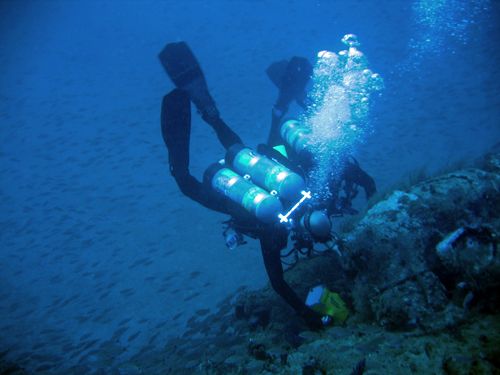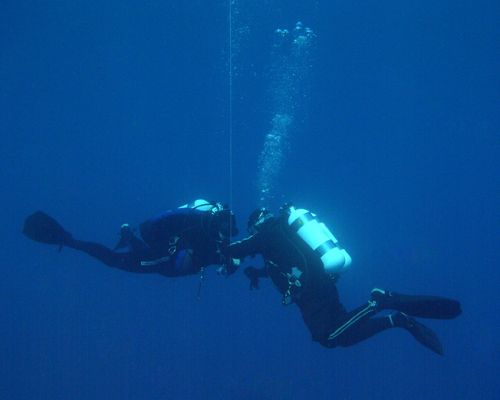what is the bends and how do they relate to gas laws
SCUBA Diving and Gas Laws
Polly Dornette
Product Developer and Former SCUBA Teacher
Students are oft fascinated by extreme sports such as SCUBA (Cocky-Contained Underwater Breathing Apparatus) diving. This interest can be harnessed to teach an exciting lesson on gas laws and their importance to SCUBA diving. Note: SCUBA diving is a sport filled with many inherent dangers and requires specialized training and equipment. Do non endeavor whatever diving activity without proper preparation and certification.

© J. Robert Patrick
SCUBA diving basics
The dry air we breathe every twenty-four hour period is composed of 21% oxygen, 78% nitrogen, and <one% other gases. Its average pressure at sea level is ane atm (14.vii psi). For SCUBA, this air is compressed into a SCUBA cylinder or "tank." SCUBA tanks tin can be made of steel or aluminum; each of these materials has pros and cons that impact the diver's conclusion on which type to apply.
The compressed air in the tank is delivered to the diver through a regulator, which reduces the force per unit area from the tank to friction match the ambience pressure. At the surface, ambient pressure is ane atm and it increases past 1 atm for every 10 yard in depth through which a diver descends. Note: Other gas mixes such as nitrox (an oxygen/nitrogen mixture with a greater amount of oxygen than air), heliox (a helium and oxygen mixture), and trimix (a mixture of oxygen, nitrogen, and helium) or even pure oxygen are also used for technical diving, but those mixes go beyond the scope of this discussion.
Boyle'south police force: P 1 V i = P two V 2
A fundamental rule of SCUBA diving is to "never concur your jiff." A expect at Boyle'southward law explains why this rule exists. When a diver inhales air from a SCUBA tank, the air that enters the diver'southward lungs is at ambient pressure. If a diver inhales from the tank on the surface, the pressure level in her lungs will be at one atm. If she inhales air from her tank at a depth of 30 thousand (~99 ft), the force per unit area in her lungs will exist 4 atm (30 thousand / x m/atm = 3 atm from the water plus 1 atm from the air at the surface = 4 atm). Assuming the diver'southward lung volume is 1 L, we tin can consummate the left side of the equation for Boyle'due south police. If a diver at 30 thou has 1 L (V ane) of air at a pressure level of 4 atm (P 1) in her lungs and ascends to the surface (P ii) while holding her breath, the following equation applies:
Solving for V 2, nosotros see that the diver's lung volume would increase to 4 times its typical volume. This increase volition effect in severe harm to the lungs, which can be fatal. The increase of volume with a decrease in force per unit area can likewise be seen in the gas bubbles exhaled by a diver as she rises to the surface. The exhaled air bubbling are modest at depth and increase in size as they travel towards the surface. See the photograph.

© John Simone
Subsequently working through this example, students often enquire why free divers are able to swoop to such extreme depths. Free divers make full their lungs at the surface with air at ambient pressure (P one) then descend while holding their breath. The force per unit area modify has the opposite impact on the book of their lungs. A gratis diver diving to a depth of 30 m would have his lungs shrink to ¼ of their initial volume, which tin can be adamant using the post-obit equation:
SCUBA instructors sometimes demonstrate this principle to their students by bringing a foam cup along on a dive. As the pressure increases with depth, the gas bubbling trapped in the foam subtract in book, shrinking the cup.
Boyle'south law also has implications on the amount of air used from the tank with each jiff. At 10 m (2 atm) twice every bit many oxygen and nitrogen molecules are inhaled with each jiff. Deeper dives crave closer monitoring of a diver's air supply because the diver uses his supply more chop-chop. Some other question students oftentimes enquire in this discussion is, "How is the SCUBA tank impacted by these changes in force per unit area?" Because the tank is a rigid container, its volume is not altered with the change in external pressure nor is the gas information technology contains affected.
Gay-Lussac'southward constabulary: P i / T 1 = P ii / T two
In SCUBA diving, Gay-Lussac's law (sometimes referred to as Amontons' police of pressure level-temperature) is most of import in relation to the amount of breathable air in a tank. The pressure of an "empty" tank is low (around 500 psi), and the temperature is equal to the ambient temperature. SCUBA tanks made out of aluminum typically have a rated fill pressure of 3,000 psi.
A SCUBA tank is a rigid container, therefore its volume is held constant. When a tank is filled, additional oxygen and nitrogen molecules are added to the tank and the pressure and temperature increase. If a tank is filled chop-chop to 3,000 psi (P 1), its temperature can ascent to as much as 150° F (65.6° C). Since all gas laws utilize absolute temperatures, this temperature needs to be converted.
Most students know they can convert a Celsius temperature to an absolute temperature of Kelvin past calculation 273. Yet, they are non probable to be aware that they tin add 460 to a Fahrenheit temperature to convert information technology to a Rankine temperature, which is based on the Fahrenheit calibration but with zero representing absolute zero. As the tank cools to ambient temperature (T ii) after the rapid make full, the gas pressure in the tank volition also decrease. Assuming the ambient temperature is 70° F (21° C), the following equations can be used to determine the pressure at the lower temperature:
Using the Kelvin scale:
T 1 = 65.6 + 273 = 338.half-dozen Yard
T ii = 21 + 273 = 294 Thousand
iii,000 psi / 338.six K = P 2 / 294 Chiliad
P 2 = 2,604 psi
Using the Rankine scale:
T 1 = 150 + 460 = 610 R
T 2 = 70 + 460 = 530 R
3,000 psi / 610 R = P ii / 530 R
P 2 = two,606 psi
Charles's law: V ane / T 1 = V 2 / T two
Charles'due south law is seldom relevant to diver safety; however, the implications of this law are responsible for an interesting miracle for divers using dry suits. A dry suit is a watertight garment worn past defined (typically over warm clothing) that serves to keep the diver warm by trapping a layer of air betwixt the diver and the suit. Dry suits are usually worn in common cold air and/or h2o temperatures.
During the dive, divers can add and remove air from their dry out suits through their regulators. This allows them to adjust for changes in their suits' gas volumes due to pressure changes during assent and descent. If the air temperature is colder than the water temperature when the defined sally at the end of the dive, they can go "vacuum sealed" in their suits due to the decrease in their suits' gas volumes. Defined can add air to the suits from their tanks, or unzip their suits, to release the "clasp."
Dalton'south law: P Total = P one + P ii + P 3 . . .
Too known as Dalton's law of partial pressures, this law states that the total pressure level of a gas mixture is equal to the sum of the partial pressures of its component gases. Equally mentioned earlier, dry air is a mixture equanimous of 21% oxygen and 78% nitrogen. Both of these gases tin can take negative impacts on a diver at high pressures. Low partial pressures of oxygen are as well dangerous but are only an issue for technical diving, which is beyond the scope of this discussion.
Oxygen can get toxic to a diver when the partial pressure level of the oxygen breathed is above ane.six atm. Symptoms of oxygen toxicity tin can include changes in vision, dizziness/vertigo, and seizures, all of which tin can be problematic for a diver and can atomic number 82 to decease. To calculate at what depth a diver might begin to feel symptoms of oxygen toxicity when diving with compressed air, we need to first calculate at what air pressure would the fractional pressure of oxygen be equal to one.6 atm or greater.
At 1 atm of total pressure for air, oxygen would have a fractional force per unit area of 0.21 atm. Therefore, the total pressure of the air would be 7.6 atm (one.half-dozen/0.21 atm) for the partial pressure of oxygen to be at 1.6 atm or greater. Remember that for each ten m of depth the pressure increases by one atm, only the pressure at the surface is ane atm, and then the fractional pressure of oxygen in air would be 1.6 atm at 66 m (216 ft).
Nitrogen narcosis can effect from a diver's exposure to loftier partial pressures of nitrogen during her dive. Symptoms of nitrogen narcosis near closely resemble those of alcohol intoxication. These symptoms appear more gradually than those of oxygen toxicity merely also increase with depth.
Henry's police force
Henry'southward law states that the concentration of a gas dissolved in a liquid at a given temperature is directly proportional to the partial pressure of the gas above the liquid. The implication of this law for SCUBA diving is that as depth increases (and therefore pressure level) the amount of a gas dissolved in the diver'southward blood volition as well increment. Oxygen is consumed by the body's physiological processes, but nitrogen is physiologically inert. The longer that a diver remains at depth, the more nitrogen is dissolved in his blood.
During long dives a considerable amount of nitrogen tin can be dissolved in the diver's bloodstream. When the diver ascends the partial pressure level of nitrogen drops, and due to Henry'southward law the dissolved nitrogen begins to come up out of solution. Nitrogen bubbles grade in the diver'southward bloodstream, which can lead to decompression sickness (DCS).
The symptoms of DCS and their severity depend on where in the diver'southward body the bubbling drift and tin range from soreness in the joints or blisters under the skin to death. Treatment for DCS typically involves several sessions in a hyperbaric oxygen chamber. In their training, defined are taught to stay within dive time and depth limits to minimize their risk of DCS and to ascend slowly from every dive.
Related products
For further exploration of the gas laws, we recommend the following products:
- Spouting Cylinder (item #752529)
- Inquiries in Science®: Expanding on the Gas Laws Kit (item #251205)
- Carolina STEM Challenge®: Cartesian Defined Kit (item #750024)
herzogtogglike1993.blogspot.com
Source: https://www.carolina.com/teacher-resources/Interactive/scuba-diving-and-gas-laws/tr29802.tr
0 Response to "what is the bends and how do they relate to gas laws"
Postar um comentário